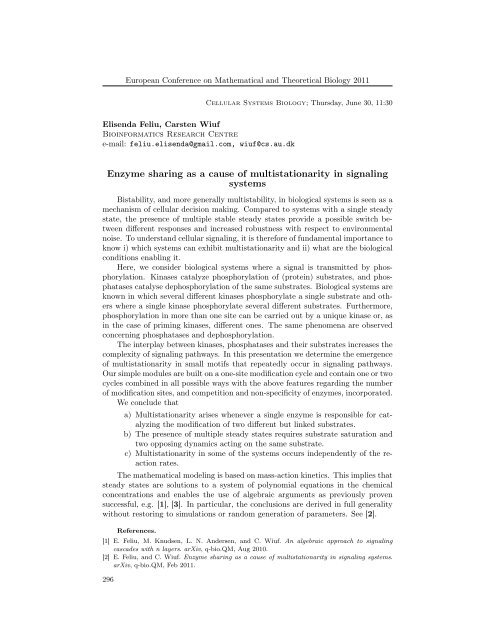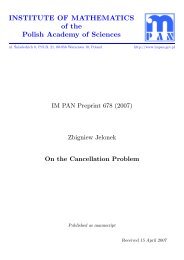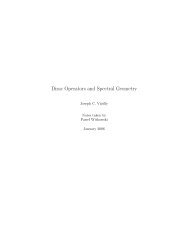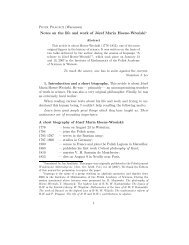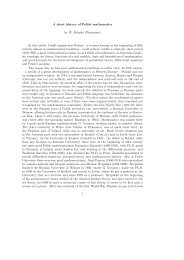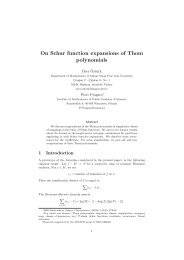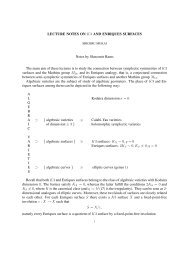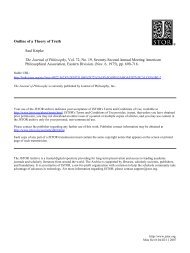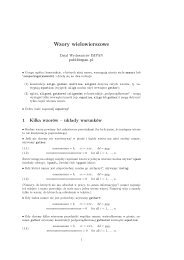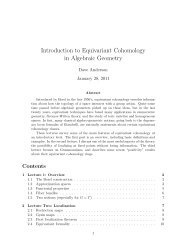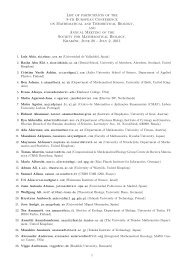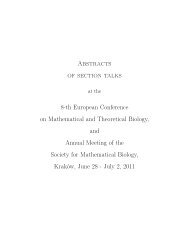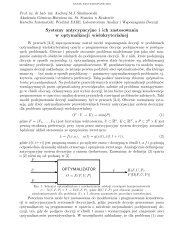Abstracts of Posters 8-th European Conference on Mathematical ...
Abstracts of Posters 8-th European Conference on Mathematical ...
Abstracts of Posters 8-th European Conference on Mathematical ...
You also want an ePaper? Increase the reach of your titles
YUMPU automatically turns print PDFs into web optimized ePapers that Google loves.
<str<strong>on</strong>g>European</str<strong>on</strong>g> <str<strong>on</strong>g>C<strong>on</strong>ference</str<strong>on</strong>g> <strong>on</strong> Ma<str<strong>on</strong>g>th</str<strong>on</strong>g>ematical and Theoretical Biology 2011<br />
Elisenda Feliu, Carsten Wiuf<br />
Bioinformatics Research Centre<br />
e-mail: feliu.elisenda@gmail.com, wiuf@cs.au.dk<br />
Cellular Systems Biology; Thursday, June 30, 11:30<br />
Enzyme sharing as a cause <str<strong>on</strong>g>of</str<strong>on</strong>g> multistati<strong>on</strong>arity in signaling<br />
systems<br />
Bistability, and more generally multistability, in biological systems is seen as a<br />
mechanism <str<strong>on</strong>g>of</str<strong>on</strong>g> cellular decisi<strong>on</strong> making. Compared to systems wi<str<strong>on</strong>g>th</str<strong>on</strong>g> a single steady<br />
state, <str<strong>on</strong>g>th</str<strong>on</strong>g>e presence <str<strong>on</strong>g>of</str<strong>on</strong>g> multiple stable steady states provide a possible switch between<br />
different resp<strong>on</strong>ses and increased robustness wi<str<strong>on</strong>g>th</str<strong>on</strong>g> respect to envir<strong>on</strong>mental<br />
noise. To understand cellular signaling, it is <str<strong>on</strong>g>th</str<strong>on</strong>g>erefore <str<strong>on</strong>g>of</str<strong>on</strong>g> fundamental importance to<br />
know i) which systems can exhibit multistati<strong>on</strong>arity and ii) what are <str<strong>on</strong>g>th</str<strong>on</strong>g>e biological<br />
c<strong>on</strong>diti<strong>on</strong>s enabling it.<br />
Here, we c<strong>on</strong>sider biological systems where a signal is transmitted by phosphorylati<strong>on</strong>.<br />
Kinases catalyze phosphorylati<strong>on</strong> <str<strong>on</strong>g>of</str<strong>on</strong>g> (protein) substrates, and phosphatases<br />
catalyse dephosphorylati<strong>on</strong> <str<strong>on</strong>g>of</str<strong>on</strong>g> <str<strong>on</strong>g>th</str<strong>on</strong>g>e same substrates. Biological systems are<br />
known in which several different kinases phosphorylate a single substrate and o<str<strong>on</strong>g>th</str<strong>on</strong>g>ers<br />
where a single kinase phosphorylate several different substrates. Fur<str<strong>on</strong>g>th</str<strong>on</strong>g>ermore,<br />
phosphorylati<strong>on</strong> in more <str<strong>on</strong>g>th</str<strong>on</strong>g>an <strong>on</strong>e site can be carried out by a unique kinase or, as<br />
in <str<strong>on</strong>g>th</str<strong>on</strong>g>e case <str<strong>on</strong>g>of</str<strong>on</strong>g> priming kinases, different <strong>on</strong>es. The same phenomena are observed<br />
c<strong>on</strong>cerning phosphatases and dephosphorylati<strong>on</strong>.<br />
The interplay between kinases, phosphatases and <str<strong>on</strong>g>th</str<strong>on</strong>g>eir substrates increases <str<strong>on</strong>g>th</str<strong>on</strong>g>e<br />
complexity <str<strong>on</strong>g>of</str<strong>on</strong>g> signaling pa<str<strong>on</strong>g>th</str<strong>on</strong>g>ways. In <str<strong>on</strong>g>th</str<strong>on</strong>g>is presentati<strong>on</strong> we determine <str<strong>on</strong>g>th</str<strong>on</strong>g>e emergence<br />
<str<strong>on</strong>g>of</str<strong>on</strong>g> multistati<strong>on</strong>arity in small motifs <str<strong>on</strong>g>th</str<strong>on</strong>g>at repeatedly occur in signaling pa<str<strong>on</strong>g>th</str<strong>on</strong>g>ways.<br />
Our simple modules are built <strong>on</strong> a <strong>on</strong>e-site modificati<strong>on</strong> cycle and c<strong>on</strong>tain <strong>on</strong>e or two<br />
cycles combined in all possible ways wi<str<strong>on</strong>g>th</str<strong>on</strong>g> <str<strong>on</strong>g>th</str<strong>on</strong>g>e above features regarding <str<strong>on</strong>g>th</str<strong>on</strong>g>e number<br />
<str<strong>on</strong>g>of</str<strong>on</strong>g> modificati<strong>on</strong> sites, and competiti<strong>on</strong> and n<strong>on</strong>-specificity <str<strong>on</strong>g>of</str<strong>on</strong>g> enzymes, incorporated.<br />
We c<strong>on</strong>clude <str<strong>on</strong>g>th</str<strong>on</strong>g>at<br />
a) Multistati<strong>on</strong>arity arises whenever a single enzyme is resp<strong>on</strong>sible for catalyzing<br />
<str<strong>on</strong>g>th</str<strong>on</strong>g>e modificati<strong>on</strong> <str<strong>on</strong>g>of</str<strong>on</strong>g> two different but linked substrates.<br />
b) The presence <str<strong>on</strong>g>of</str<strong>on</strong>g> multiple steady states requires substrate saturati<strong>on</strong> and<br />
two opposing dynamics acting <strong>on</strong> <str<strong>on</strong>g>th</str<strong>on</strong>g>e same substrate.<br />
c) Multistati<strong>on</strong>arity in some <str<strong>on</strong>g>of</str<strong>on</strong>g> <str<strong>on</strong>g>th</str<strong>on</strong>g>e systems occurs independently <str<strong>on</strong>g>of</str<strong>on</strong>g> <str<strong>on</strong>g>th</str<strong>on</strong>g>e reacti<strong>on</strong><br />
rates.<br />
The ma<str<strong>on</strong>g>th</str<strong>on</strong>g>ematical modeling is based <strong>on</strong> mass-acti<strong>on</strong> kinetics. This implies <str<strong>on</strong>g>th</str<strong>on</strong>g>at<br />
steady states are soluti<strong>on</strong>s to a system <str<strong>on</strong>g>of</str<strong>on</strong>g> polynomial equati<strong>on</strong>s in <str<strong>on</strong>g>th</str<strong>on</strong>g>e chemical<br />
c<strong>on</strong>centrati<strong>on</strong>s and enables <str<strong>on</strong>g>th</str<strong>on</strong>g>e use <str<strong>on</strong>g>of</str<strong>on</strong>g> algebraic arguments as previously proven<br />
successful, e.g. [1], [3]. In particular, <str<strong>on</strong>g>th</str<strong>on</strong>g>e c<strong>on</strong>clusi<strong>on</strong>s are derived in full generality<br />
wi<str<strong>on</strong>g>th</str<strong>on</strong>g>out restoring to simulati<strong>on</strong>s or random generati<strong>on</strong> <str<strong>on</strong>g>of</str<strong>on</strong>g> parameters. See [2].<br />
References.<br />
[1] E. Feliu, M. Knudsen, L. N. Andersen, and C. Wiuf. An algebraic approach to signaling<br />
cascades wi<str<strong>on</strong>g>th</str<strong>on</strong>g> n layers. arXiv, q-bio.QM, Aug 2010.<br />
[2] E. Feliu, and C. Wiuf. Enzyme sharing as a cause <str<strong>on</strong>g>of</str<strong>on</strong>g> multistati<strong>on</strong>arity in signaling systems.<br />
arXiv, q-bio.QM, Feb 2011.<br />
296


